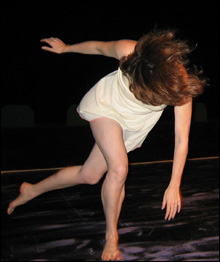
MAKING FUN OF REPETITION: But Lorraine Chapman wasn’t funny.
|
You can’t really depend on the instructive power of a title. CrashArts’ “Dance Straight Up!” series at Zero Arrow Theatre offered two new dances by local choreographers Friday night. Debra Bluth’s Beauty, Danger, Life (and it all pleased her), which was inspired by an invisible anecdote, and Lorraine Chapman’s the solemn moment, a parody on dancing, were a long way from high metaphysics. Both pieces were loosely connected “pure dance” suites with assorted accompaniments, from silence to dancer-generated sounds and wildly eclectic music. Bluth works very straightforwardly with one or two dancers at a time to generate little movement essays suggesting states of mind or intentions. Each dance has a word or two at the top and, as she writes, a “set of directions that guides it.” There’s an overall story in the background too, but none of this affects the viewer in any literal way.
What you’re aware of is a string of concentrated activities: comings and goings, connection and repulsion, excitement and subsidence. Nothing more than these, but each theme gets satisfyingly explored on the spot. The dance looked improvised but not random. The dancers could have worked out the main outlines in advance, to be filled in spontaneously at each performance.
Andy Taylor-Blenis, in a long full skirt, began with hand and arm movements, scooping and slicing into the air around her. She stamped once with a flexed foot like a Balinese dancer. These movement motifs spread into her whole body until she was twisting and shaping, engrossed in a sphere of energy around her body. She developed the stamps into a short phrase, with swaying hips and almost coquettish shoulders, an incipient folk dance that slipped away in the quick currents of invention.
Taylor-Blenis left and Bluth appeared at one side of the stage, intent on getting across. With more agitated, less connected gestures, she stared into the horizon and made her way, backing up a step or two, but then forging ahead again. A few times she looked back over her shoulder, but she never gave up the journey.
Ali Essakalli and Ethan Time, in identical pants and shirts, maneuvered and circled ambiguously. Their task seemed to be to keep moving and to keep connected with only the lightest, peripheral contact — touching but not holding each other.
Olivier Besson swiveled and levitated no-handed on a chair. Later, when Bluth approached him, he grew attached to her, too. She fixed her gaze on him; he avoided eye contact but incorporated her physicality, balancing and draping around the chair with her. Perhaps they were competing for territory, but the desire for possession turned into an erotic game. Nothing was going to stop her from winning, and after a brief retreat, she came back and dragged him off.
Bluth’s dance placed the utmost confidence in the dancers’ ability to hold our attention, to create movement narratives. Lorraine Chapman’s high-context piece for seven women seemed to assume we’d be interested only if they undercut their movement material in the act of performing it.